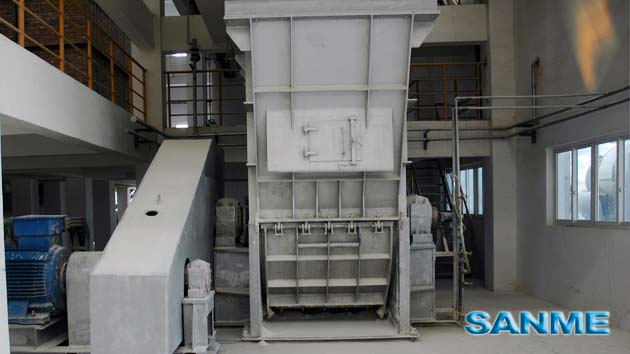Gypsum powder is one of five major cementing materials, and plays an important role in national economy, gypsum powder production line is to heat and grind the natural dihydrate gypsum ore or industrial byproduct gypsum .

Material: Gypsum, chalk, clay, slurry and filter cake.
Application: Heating Plant of limestone desulfurization project, stone powder maker for high-grade highways, coal grinding mill in environmental protection type boiler plant, the mill in mining firms.
Equipments: DSJ series drying hammer mills
It is based on more than twenty years of researching and developing experience on powder maker by Sanme scientific specialist staff. In view of characteristics of gypsum, we develop a production technology with high output and high efficiency, which is named as drying process. It materializes self-grinding and self-selecting, and can directly grind the gypsum by VSD powder concentrator into powder which measures up to the building gypsum standard of GB/T9776—2008, no necessity of external screening and sorting. Besides, due to the internal circulating wind, the finished gypsum powder is blown out very fast, which is not only avoid of over-grinding, but improve the output and efficiency. Moreover, the adoption of advanced dust-remover makes the system achieve the state environment protection requirements.
The gypsum ores are crushed into small granules of the size less than 30mm, conveyed to mills to complete selecting and separating, and then the qualified powder are delivered into fluidized bed boiler for calcinations while the rest return to the mill. The qualified gypsum powders are carried into the storage bin or workshop for further use.
The gypsum and FGD gypsum are fed from the inlet, effective contacting the surface of the heat exchange tube in the shell, and be burnt by the fume as a medium from the fluidized bed boiler and finally collected in the discharge outlet. Owing to the indirect heat exchange, the shell obtains higher regional vapor pressure which has positive effects on the quality of products. Moreover, there is no direct contact between the gypsum and heat carrier that keeps the maximum purity of the products. Indirect heat exchange model of rotating calcinations technique can effectively protect the gypsum against semi-hydrated gypsum by balancing the strength of the calcinations. This processing, adopting the advanced technology and taking the fluidized bed boiler as the heat source, which lowers the consumption of coal to its fullest extent and makes the full use of heat with output 100-1000t, is the ideal equipment for the calcinations of gypsum industry.
Based on the process requirements, the construction gypsum product lines include crusher, mills, calcinations, storage and conveyor and control systems.
(1) Crushing system: The gypsum ores are fed into crushers by the vibrating feeder, and crushed into small granules of the size less than 30mm for later use. Based on size of products and capacity requirements, the appropriate models can be adopted, like PE jaw crusher, PC hammer mills and PF impact crushers, etc. The dust collector is optional in order to keep the environment clean and satisfy the emission requirements.
(2) Conveying system: The crusher gypsum is conveyed into the storage bin by the lifter. The design of the storage bin is based on requirements of the storage time to ensure stable supply.
(3) Mill system: The materials are fed evenly and continuously into the mill by the vibrating feeder for grinding, and then the ground gypsum are blowing out by the blower for the analyzer to classify. The qualified powders go with the wind to the collector and are discharged by the tube as the final products which fall on the auger conveyors for the next stages of calcinations. It is close-recycled that the whole wind system is and adopts the bag filter between the wind collector and blowers, which filter the dust in the air and release into the atmosphere so as to prevent environment from pollution. The material sizes through mill system are changed from 0-30mm to 80-120 mesh and satisfy the gypsum requirements.
The mill system includes a lifter, storage bin, vibrating feeder, mills, auger conveyor and bag-type collector. The mill is adopting our latest patented Euro-typed miller (patented number is ZL 2009 2 0088889.8,ZL 2009 2 0092361.8,ZL 2009 2 0089947.9). There is an inside classifier, no necessity of outside one, which simplify the process.
(4) Calcinations system: It includes the lifter, fluidized bed boiler, electro-static dust remover, roots blower, etc. The fluidized bed boiler is the most widely-used calcinations equipments in our country at present, which features smart shape, great capacity and simple structure, low failure rate and compact shape, low consumption, easy operation and self-control materialization, good quality of gypsum with ideal composure and stable physical performance, low operation cost, etc. It is widely used in the calcinations process of natural gypsum and chemical gypsum.
(5) Control system: It takes the advanced centralized-control technology, DCS control and PLC control, adopting the well-known branded controls elements.
Download the lastest products including Crusher, Mobile Crusher, Screens and Feeds of Sanme.
Jaw Crusher - Hydraulic Cone Crusher - Impact Crusher - Sand Making Machine - Hammer Crusher
Copyright ©2009 Shanghai Sanme Mining Machinery CO., Ltd All rights reserved.